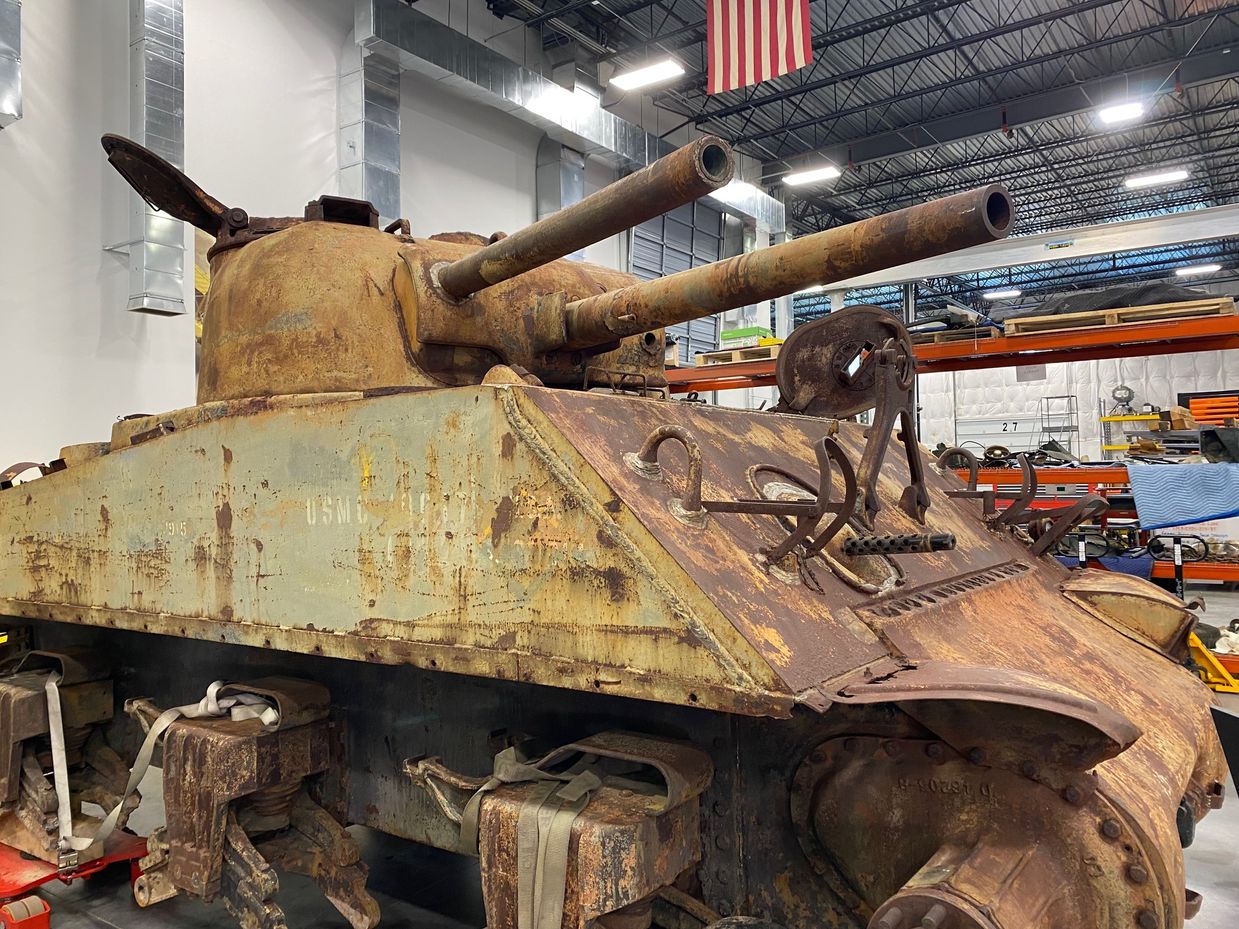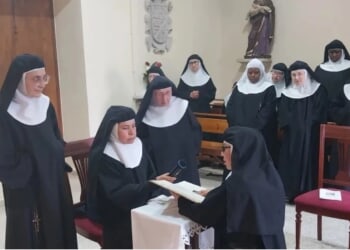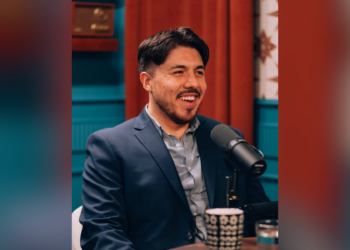
An Indiana veteran reunited Friday with the M4A3 Sherman tank he served in as a young Marine during the Battle of Iwo Jima in 1945. The tank, nicknamed “Lucky,” took part in several intense fights during a bloody campaign that lasted more than a month.
Leighton Willhite was a 19-year-old corporal in the 5th Tank Battalion when he drove Lucky off a Navy landing ship and onto the gritty, black sand of Red Beach 2. It was a new model of the venerable Sherman tank that was making its combat debut on Iwo Jima.
“This is amazing. I never thought I’d see the tank again,” Mr. Willhite, now 100, said on Friday at the National Museum of the Marine Corps’ support building, where a now rust-covered Lucky is slowly being brought back to life.
“I could start that tank and put it anywhere you wanted,” he said. “I may not have been the best driver, but I wasn’t the worst.”
The tanks landed on the island about three hours after the first wave of Marine Corps infantry, but the beach was far from secure. They were bombarded with mortars fired by the Japanese defenders before Lucky and the other Sherman tanks pushed farther onto the island.
“We went all the way onto the other end of the island, then turned around and came back,” Mr. Willhite recalled.
Another tank in the battalion, nicknamed Jeannie, got knocked out during heavy combat north of Mount Suribachi. Then Corporal Willhite volunteered to cover his tank commander, Lt. Leonard Blake, while he moved forward on foot to assist the stricken crew. It was an act of bravery that earned Mr. Willhite the Bronze Star for Valor and a Silver Star for Lt. Blake.
“I wouldn’t lie to anyone. I was scared,” Mr. Willhite said. “But we were proud that we accomplished something.”
It was Lt. Blake who gave the tank its nickname. Mr. Willhite didn’t know if “Lucky” had been named for someone or was supposed to be some kind of good luck charm.
“He was a really fine person,” he recalled. “The whole tank crew was good.”
About four days after the invasion, Mr. Willhite parked the tank and joined with other troops at the summit of Mount Suribachi. He was there when six of his fellow Marines raised a U.S. flag in an iconic moment that was captured in the famous image by Associated Press photographer Joe Rosenthal.
“I had the choice of holding the flag when it went up, but I didn’t want to,” Mr. Willhite recalled.
The battle raged on for another 31 days after the raising of the Mount Suribachi flag. Lucky was returned to Hawaii after the fighting on Iwo Jima was over. It was one of 72 Sherman tanks selected for conversion into a CB-H5 flamethrower tank in preparation for the planned invasion of Japan. It was placed in storage after Japan’s surrender and eventually transferred to Camp Lejeune in North Carolina.
“At one point, they wanted to make it a monument tank, but they didn’t have the money. So it was just pushed off into the woods,” said Jonathan Bernstein, the arms and armor curator at the National Museum of the Marine Corps in Triangle, Va.
While Mr. Willhite and the other Marines returned home and continued with their lives, Lucky spent the decades becoming a forgotten and slowly rusting hulk.
Master Gunnery Sgt. Lisa Marshall was new to the Corps in 2002 when she and some of her fellow Marines spotted something out of the ordinary that was surrounded by a thick grove of trees and bushes. Although Marine tankers had long transitioned to the M1 Abrams, they recognized it as an M4 Sherman — one of almost 50,000 that were built in the U.S. between 1942-1945.
The Marines decided Lucky deserved a better fate than to be abandoned in the woods. But getting it out would not be easy.
“We had to do a lot of work with shovels just to expose enough of the tank to get a sled underneath it so we could pull it out,” Master Gunny Marshall said.
Lucky was turned over to the Marine Corps Museum, where it was placed in storage for several years. In 2020, it was loaned to the Pima Air and Space Museum in Tucson, Arizona. Mr. Bernstein visited the site in June 2023 to inspect the still-unidentified tank.
He identified welding scars and field modifications on the tank that positively identified it as part of C Company, 5th Tank Battalion. A closer examination revealed the tank’s nickname and tactical markings that confirmed its role during the Iwo Jima campaign and directly linked it to Leighton Willhite.
Mr. Bernstein said formally identifying the tank was merely the “end of the beginning.” Lucky will undergo an “external restoration” combined with an “internal stabilization” to make sure it doesn’t further deteriorate. The goal is for Lucky eventually to become an exhibit at the museum — restoration could take five years.
Mr. Willhite said he plans to still be around when Lucky is unveiled in all her glory.
“It was my home. I thought being in that Sherman was the only way I was going to make it,” Mr. Willhite said.


![Man Arrested After Screaming at Senators During Big Beautiful Bill Debate [WATCH]](https://www.right2024.com/wp-content/uploads/2025/06/Man-Arrested-After-Screaming-at-Senators-During-Big-Beautiful-Bill-350x250.jpg)














